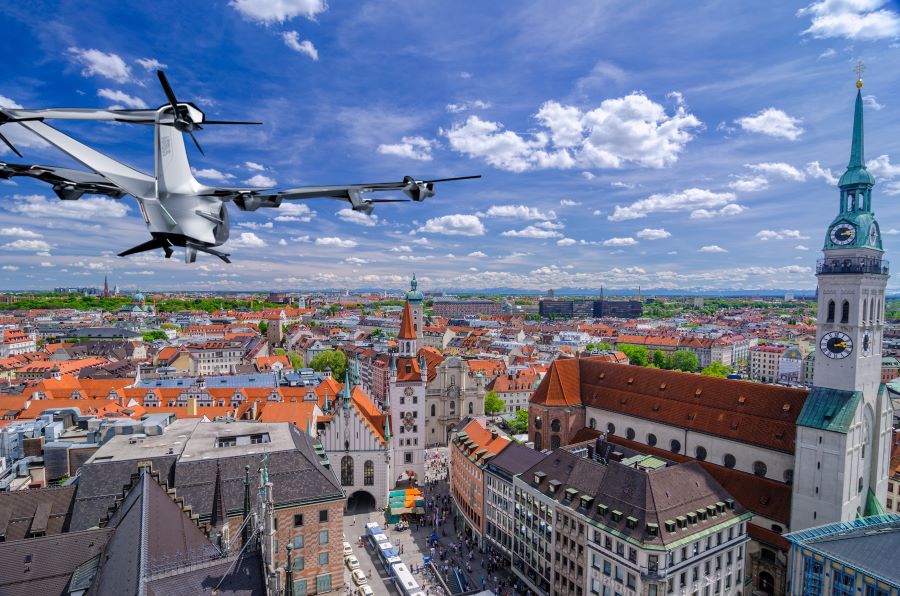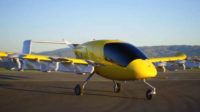The future of mobility was just around the corner. Cars would drive themselves. Urban air mobility (UAM), a new transportation mode involving electric-powered flying vehicles, would revolutionize city commutes. Then COVID-19 happened, inflicting previously unimaginable harm and havoc on the world.
For many automotive companies, this meant pausing sky-high plans for the more sobering and necessary task of producing medical equipment. It also meant getting back to basics: Manufacturing service parts, quality components, and reliable vehicles to ensure people can get from point A to B safely during this incredibly difficult time.
But over the long-term, and as the world reopens, the high-minded notions about UAM’s transformative power have not been grounded.
Traffic will again clog city streets. Commuters, more skeptical of public transportation’s cleanliness, might favor more isolated to-order transit options. The demand for greener and more efficient transportation modes will not go away.
That is why, when UAM comes back into focus, its players—from aerospace heavyweights to nimble startups—stand to learn much from the century-old auto industry.
For one thing, there are many synergies between the automotive and aerospace sectors. Both are rooted in safety, quality, and manufacturing. But the auto industry’s unique ability to bring these values to life at incredible scale is essential to UAM’s future success. As this nascent market looks upward for growth, here is how its four-wheeled friends on the ground can give it a lift.
360-degree sensing for 360-degree travel
For years, the auto industry has been developing autonomous vehicles and placing a heightened focus on advanced in-vehicle safety and navigation systems like innovative radar and 360-degree sensing. The importance of this type of technology essentially doubles when it comes to UAM vehicles, since radar sensing will no longer just be required on the sides of vehicles, but also above and below.
As auto industry companies have spent years perfecting this technology, it is only natural that they will be on the forefront of helping it “take-off” as well.
Electrifying movement
Utilizing hybrid and electric propulsion systems will be just as important as safety for UAM manufacturers, with four in 10 Americans living with unhealthy air, according to the American Lung Association (https://bit.ly/2MWqhxW). And air pollution is a topic that is seeing even more attention as COVID-19 swept the world; in fact, electric car sales have doubled during the coronavirus outbreak, according to Forbes (https://bit.ly/3fgLz5G).
UAM vehicles must utilize hybrid and electric propulsion systems to ensure they do not add to air pollution, and auto companies have been working to perfect that technology for decades.
In addition, while the automotive industry has made strides in improving battery life—most electric vehicles (EVs) can travel 100-miles plus before charging—taking it to the skies is next-level. Though significant progress has been made in lithium-ion batteries, according to Axios (https://bit.ly/37qykwL), global automakers are still investing heavily to improve battery performance for EVs—and potentially for UAM solutions.
Putting the shhhh in mobility shifts
Urban air taxis will fly over communities and homes at low altitude, so they must be quiet. This need is magnified as more people are working from their homes versus downtown office buildings that are soundproofed for traffic.
As it happens, electric cars are extremely quiet, with some saying they may be too quiet, according to Axios (https://bit.ly/2UUu7MP). Nevertheless, the technologies that power them could apply, with slight alterations, to urban air vehicles. However, this concern about silent travel on the road flips into a positive in the sky, making electrified air taxis ideal for urban spaces and helping to reduce noise pollution.
And given that electric motors and inverters are already in mass production, high-quality control can be achieved—a necessity to building public trust in this new market.
The COVID-19 pandemic has taught us that we must look to new-mobility solutions for our communities to function safely and efficiently. UAM presents a tangible solution to this by alleviating congestion while simultaneously improving air quality. It is without a doubt that it will play a key role in the future of mobility ecosystems.
As the world emerges from quarantine, expect to see not only the aerospace industry leading the charge into UAM, but traditional automakers and suppliers playing key roles in getting this new mobility solution off the ground (pun intended).




